The CMG Website is pleased to welcome Wizzie N. Brown to our website. Wizzie is the Integrated Pest Management and Entomology agent for the Travis County AgriLife Extension Service and writes periodic articles on various aspects of entomology. She has agreed to let us post her articles–thank you Wizzie! We think you’ll find them interesting and informative.
Questions? You can contact Wizzie at 512.854.9600 or the website at email@comalmg.com
March 2024–Leaf Cutting Ants
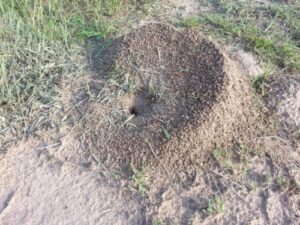 Texas leafcutting ants, Atta texana, are fascinating ants native to Texas, Louisiana, and parts of Mexico. Leafcutting ants create large, extensive colonies, often with multiple mounds clustered in a single area. Mounds are volcano or crater-shaped with a centralized opening and may be mistaken for fire ant mounds, but fire ant mounds do NOT have a centralized opening.
Texas leafcutting ants, Atta texana, are fascinating ants native to Texas, Louisiana, and parts of Mexico. Leafcutting ants create large, extensive colonies, often with multiple mounds clustered in a single area. Mounds are volcano or crater-shaped with a centralized opening and may be mistaken for fire ant mounds, but fire ant mounds do NOT have a centralized opening.
Usually, worker ants of this species, who forage for food, are the most commonly seen leafcutting ants, but in spring it is possible to see reproductive ants, or swarmers. Workers are relatively large ants, reddish-brown in color with three pairs of spines on the thorax and one pair of spines on the back of the head. Workers come in various sizes but can be up to ½ an inch long. Reproductives look similar to worker ants but are much larger in size, with female swarmers being over an inch long. 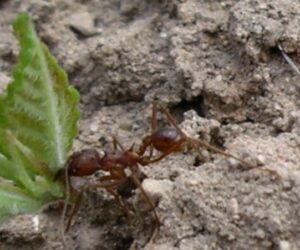 Mated queens have a special area within their mouth to carry fungal spores used to create a fungus garden in the newly founded nest.
Mated queens have a special area within their mouth to carry fungal spores used to create a fungus garden in the newly founded nest.
Leafcutting ants typically forage when temperatures are cooler, such as at night or in the morning. They can sometimes cause complete defoliation of plants or small trees overnight. These ants remove leaves and buds from plants in the landscape which they chew and get some nutrition from sap, but mainly place chewed leaves in an underground garden within their colony and use it as a base to grow fungus that they eat. Leafcutting ants tend a particular species of fungus and weed out any other fungus from their garden.
Colonies may exist for years and can exceed over two million ants. It is not unusual for a single colony to cover an acre of land. Colonies are usually found in well drained, sandy or loamy soils and are more common in Central to East Texas than other parts of the state.
 Unfortunately, leafcutting ants can be difficult to manage, and almost impossible to eradicate completely. Prized plants can be temporarily protected by using spray adhesives around the base of the plant, but adhesives need to be refreshed often when dirt or debris accumulates. Temporary protection can also be provided to prized plants by utilizing contact insecticidal sprays or dusts labeled for “ants”. These insecticidal products can also be used along foraging trails and openings where the ants go into the ground. If mounds are present, Amdro Ant Block, which is the only product labeled for use against leafcutting ants, can be broadcast with a hand-held spreader in the mound area. You do not want to use ant bait and residual dusts and sprays in the same area as pesticidal dusts and sprays can contaminate bait and cause the ants not to pick it up.
Unfortunately, leafcutting ants can be difficult to manage, and almost impossible to eradicate completely. Prized plants can be temporarily protected by using spray adhesives around the base of the plant, but adhesives need to be refreshed often when dirt or debris accumulates. Temporary protection can also be provided to prized plants by utilizing contact insecticidal sprays or dusts labeled for “ants”. These insecticidal products can also be used along foraging trails and openings where the ants go into the ground. If mounds are present, Amdro Ant Block, which is the only product labeled for use against leafcutting ants, can be broadcast with a hand-held spreader in the mound area. You do not want to use ant bait and residual dusts and sprays in the same area as pesticidal dusts and sprays can contaminate bait and cause the ants not to pick it up.
When managing leafcutting ants, set expectations at managing, not eradicating. Often when you treat, you’ll knock back a portion of the worker population, but the colony will remain.
For more information or help with identification, contact Wizzie Brown, Texas A&M AgriLife Extension Service Program Specialist at ebrown@ag.tamu.edu.
This work is supported in part by the Crop Protection and Pest Management, Extension Implementation Program [award no. 2021- 70006-35347/project accession no. 1027036] from the United States Department of Agriculture (USDA) National Institute of Food and Agriculture.
February 2024–The Exoskeleton…the part of an insect that goes crunch
Insects and other arthropods have an exoskeleton, which means their “bones” are on the outside of their body. The exoskeleton serves as a protective covering, helps prevent desiccation, allows muscles to attach to it from the inside for movement, and provides sensory information.
The exoskeleton is made up of four layers: epicuticle, procuticle, epidermis and basement membrane. The most outer layer, the epicuticle, serves as a barrier to the outside environment and helps the insect avoid desiccation. If you have ever used diatomaceous earth for insect management, you are hoping to abrade the epicuticle of the insect with the diatomaceous earth and cause enough water loss for the insect to die.
 The next layer, the procuticle, is for strength. The procuticle is made of chitin, which is secreted by the underlying third layer, the epidermis. The cuticle is soft when it is first secreted, but undergoes a process called sclerotization, which allows for hardening and darkening of the exoskeleton. The procuticle is divided into two components, the exocuticle and endocuticle. The endocuticle is tough, but flexible while the exocuticle is where thickening occurs to provide a more rigid, armored structure. With soft-bodied insects, such as termites, aphids, or caterpillars, the exocuticle layer is greatly reduced.
The next layer, the procuticle, is for strength. The procuticle is made of chitin, which is secreted by the underlying third layer, the epidermis. The cuticle is soft when it is first secreted, but undergoes a process called sclerotization, which allows for hardening and darkening of the exoskeleton. The procuticle is divided into two components, the exocuticle and endocuticle. The endocuticle is tough, but flexible while the exocuticle is where thickening occurs to provide a more rigid, armored structure. With soft-bodied insects, such as termites, aphids, or caterpillars, the exocuticle layer is greatly reduced.
The epidermis is a layer of living cells that secrete chitin that is used to create the layer above, the procuticle. Any sensory hairs, called setae, that an insect has on its body originate in the epidermis and sensory information travels through the hair on the outside of the insect’s body to nerves found in the epidermis.
The innermost layer is the basement membrane which is a support for the epidermis and a separation from the insect body cavity.
All these layers together make up the insect exoskeleton. The exoskeleton is comprised of hardened plates called sclerites. The composition of plate structure allows the insect to have segmented joints and bodies which allows for movement. Each segment has various thickness of sclerites related to the movement and/ or protection required in that given area of the body. Furthermore, the exoskeleton has various areas that are folded inward, called apodemes, allowing for more surface area of the exoskeleton in that particular region and creating a strengthened area where muscles can attach on the inside of the body.
For more information or help with identification, contact Wizzie Brown, Texas A&M AgriLife Extension Service Program Specialist at 512.854.9600.
This work is supported in part by the Crop Protection and Pest Management, Extension Implementation Program [award no. 2021- 70006-35347/project accession no. 1027036] from the United States Department of Agriculture (USDA) National Institute of Food and Agriculture.
January 2024–How to Help Overwintering Insects
If you want to help insects survive winter, there are some things you can do to provide them with shelter during colder times of the year.
First of all, why should you provide shelter for insects during winter? Not all insects are pests! It is estimated that less than 5% of insect species are considered pests which means the majority of insects are beneficial or just hanging around the landscape. Any of you that have heard me speak before know that I say that you can’t pigeonhole an insect as being bad or good based on what the insect is. You need to consider where the insect is located and what it is doing. Now that everyone is on board with helping insects out over the winter, let’s get into what you can do to help.
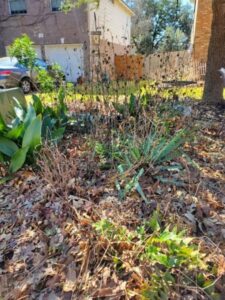 Leave the leaves. There seems to be a movement on social media with this particular slogan (hopefully it’s not trademarked). Essentially, it asks people to leave the leaves that fall to the ground in the fall as overwintering habitat for various animals. I do this in my own yard- although I have live oaks and those leaves don’t drop until spring. Fortunately, my neighbor across the way has a burr oak that drops leaves in the fall and all those leaves magically blow into my yard. Leaf litter makes great habitat not only for insects but also a bunch of other ground dwelling animals. I usually rake my leaves into my beds and then mulch over top of the leaves in the late spring.
Leave the leaves. There seems to be a movement on social media with this particular slogan (hopefully it’s not trademarked). Essentially, it asks people to leave the leaves that fall to the ground in the fall as overwintering habitat for various animals. I do this in my own yard- although I have live oaks and those leaves don’t drop until spring. Fortunately, my neighbor across the way has a burr oak that drops leaves in the fall and all those leaves magically blow into my yard. Leaf litter makes great habitat not only for insects but also a bunch of other ground dwelling animals. I usually rake my leaves into my beds and then mulch over top of the leaves in the late spring.
Leave the stems. I know this doesn’t flow off the tongue as well as the previous slogan, but it’s of similar thought. This requires you to leave any hollow stemmed plants to allow insects that overwinter/ nest inside to have spaces that are cozy to spend the winter. I do this in my landscape as well, and if I get a letter from the HOA, I write them back with an explanation as to how I am helping native pollinators as there are numerous native bees that nest in hollow stemmed plants. Once new plant growth begins to emerge the following spring, I cut back the old stems, but I don’t throw them away just yet. I place the cut stems into a back corner of my yard for any stragglers that may be taking their time to emerge.
 Partially bury a log in your yard. Do you still have logs leftover from Snowpocalypse? If so, choose one to partially bury in the yard to create a habitat for various arthropods. This is another strategy that I am using in my yard, although I think that I need to move my buried log to a location that gets better sunlight in the morning. By partially burying the log, you allow moisture in which allows it to be more habitable to a larger number of arthropods. You can have arthropods overwintering in the log, under the bark, or under the log itself.
Partially bury a log in your yard. Do you still have logs leftover from Snowpocalypse? If so, choose one to partially bury in the yard to create a habitat for various arthropods. This is another strategy that I am using in my yard, although I think that I need to move my buried log to a location that gets better sunlight in the morning. By partially burying the log, you allow moisture in which allows it to be more habitable to a larger number of arthropods. You can have arthropods overwintering in the log, under the bark, or under the log itself.
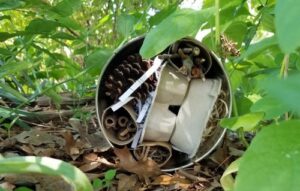 Create or buy an insect house. Insect houses can be as large or as small as fits your landscape and can fit any budget. I have both purchased insect houses- these are specifically native bee houses/ nurseries- and home-made insect houses. You can upcycle any water-resistant container into an insect house by filling it with other recycled items such as toilet paper tubes, shredded paper, pine cones, twigs, leaves, bamboo, paper egg cartons, or other natural materials. Insect houses can be placed on the ground, in the crotch of tree branches, or attached to fences or other objects.
Create or buy an insect house. Insect houses can be as large or as small as fits your landscape and can fit any budget. I have both purchased insect houses- these are specifically native bee houses/ nurseries- and home-made insect houses. You can upcycle any water-resistant container into an insect house by filling it with other recycled items such as toilet paper tubes, shredded paper, pine cones, twigs, leaves, bamboo, paper egg cartons, or other natural materials. Insect houses can be placed on the ground, in the crotch of tree branches, or attached to fences or other objects.
By providing a few simple things as overwintering areas for insects, and having to do a lot less yard work, you can ensure that you create a more insect-friendly landscape.
December 2023–Tiger Moth Caterpillars
Tiger moth caterpillars have been a common sight lately in the Central Texas area. These insects are native to the United States and are sometimes called “wooly bear caterpillars”. “Wooly bear caterpillar” is a more general term that refers to various species of caterpillars that are densely covered in hairs, called setae, and tend to wander.
While these caterpillars can be highly variable for individual species, the common ones seen lately are wooly bear (Isabella tiger moth), saltmarsh caterpillar (saltmarsh moth), and garden tiger moth caterpillar, also known as the great tiger moth caterpillar. Wooly bear caterpillars are usually black on each end with brown in the middle. Saltmarsh caterpillars are variable and can be a creamy yellow to brown to black in color. Garden/ great tiger moth caterpillars tend to be black on the top part of the body and brown on the bottom.
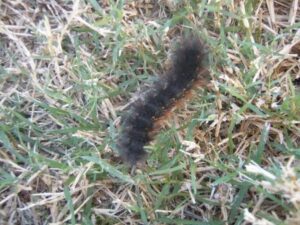
Garden/Great Tiger Moth Caterpillar
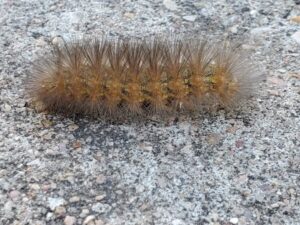
Saltmarsh Caterpillar
Tiger moths have a complete life cycle with four life stages- egg, larva, pupa, adult. Eggs are laid in clusters on the leaves of host plants. Larvae go through several instars before they pupate in soil. Larvae tend to actively disperse and may be seen in groups moving over turf, roads, sidewalks, or other locations. Adults usually emerge in the spring to mate and begin the cycle again. Moths can be active year-round in South Texas, but for most parts of Texas, larvae overwinter in the last larval instar in protected locations.
For more information or help with identification, contact Wizzie Brown, Texas AgriLife Extension Service Program Specialist at 512.854.9600.
This work is supported in part by the Crop Protection and Pest Management, Extension Implementation Program [award no. 2021- 70006-35347/project accession no. 1027036] from the United States Department of Agriculture (USDA) National Institute of Food and Agriculture.
October 2023–Tarantulas
 Tarantulas, also known as baboon spiders in Africa or hairy spiders in South America, are the largest spiders in the world. They can be found on every continent except Antarctica. Tarantulas have two body regions, eight legs, and hairy bodies. Tarantulas that are found in North and South America have hairs used in defense. These tarantulas use their legs to flick hairs off their abdomen and into the face of predators. Hairs cause irritation to the eyes and mucous membranes. Tarantulas can be attacked by birds, lizards, snakes, and tarantula hawk wasps.
Tarantulas, also known as baboon spiders in Africa or hairy spiders in South America, are the largest spiders in the world. They can be found on every continent except Antarctica. Tarantulas have two body regions, eight legs, and hairy bodies. Tarantulas that are found in North and South America have hairs used in defense. These tarantulas use their legs to flick hairs off their abdomen and into the face of predators. Hairs cause irritation to the eyes and mucous membranes. Tarantulas can be attacked by birds, lizards, snakes, and tarantula hawk wasps.
Tarantulas are nocturnal predators and feed on insects, other spiders, small lizards, frogs, and snakes. When prey is captured, it is then bitten with the spider’s fangs and injected with venom with digestive enzymes that kills and liquefies the prey. Once prey is soupy, the tarantula sucks up juices through their fangs. While tarantulas are capable of biting humans, their venom does not react with our body chemistry like widow or recluse spiders. Tarantula bites are comparable to a bee sting.
There are fifteen species of tarantulas in Texas, and they create burrows in the ground, typically in well-drained soil. They use their webbing to line burrows which helps to shore up tunnels so they do not collapse. Webbing can also be used to create a molting mat which is laid down before the tarantula sheds its exoskeleton as well as used for handling prey. In other parts of the world, tarantulas live in trees and may use webbing to create a sling as a nest. Tarantulas are solitary, so there will only be one tarantula per burrow.
Tarantulas are arthropods, so they have an exoskeleton which requires them to molt numerous times throughout their life to grow. When ready to molt, which is controlled and signaled by hormones that only arthropods have, the tarantula lays down a silken molting mat, flips over on its back, and pops open the old exoskeleton along a weakened area called the ecdysial cleavage line. The spider must push its way out of the old exoskeleton by expanding and contacting its body to help wiggle its way out. Once the spider has emerged from the old exoskeleton, it stays in place on its back until the new exoskeleton hardens and then it will flip back over.
Some in Texas may come across mass “migrations” of tarantulas. These are not true migrations as the tarantulas are not moving to live in a new area, but instead, are males out searching for females for mating.
While tarantulas may be disconcerting for people when they venture indoors, they really are not a pest and don’t warrant control. The best thing to do is to keep tarantulas outside where they belong by excluding the home so the spiders cannot enter.
(This work is supported in part by the Crop Protection and Pest Management, Extension Implementation Program [award no. 2021- 70006-35347/project accession no. 1027036] from the United States Department of Agriculture (USDA) National Institute of Food and Agriculture)